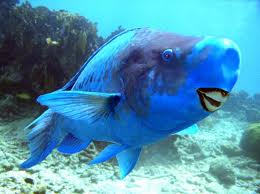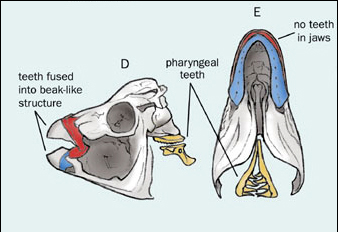Herbivory
Herbivory
Three Types of Herbivorous Fishes [1]
Reef fishes that are herbivores are typically invertebrates [2]. There are three types of herbivorous fishes. These include territorial grazers, roving grazers, and scrapers. Territorial grazers are site-attached fish that actively defend their territories against other herbivores. One example of a territorial grazer is a damselfish.

Roving Grazers are mobile herbivore fish that move around reefs in large schools. These fish feed on macro algae and epilithic algae, or algae that is found on stone. The last type of herbivorous fish are scrapers. Scrapers are highly mobile fish that consume epilithic algae and remove sediment by scraping limestone surface of reefs. A few examples of herbivorous fish include: surgeonfish, butterflyfish, angelfish[2]
Feeding Habits of Herbivore Fish/How Food is Digested[2]
Herbivorous fish focus feeding on enriched macrophytes. Shallower reefs have more herbivorous fishes and increased grazing rates as compared to deeper parts of the ocean. Some herbivorous fish prey directly on corals. Parrotfish are an example of fish that prey directly on coral. [3]

Typically, herbivorous feed on red, green, and brown macro algae[2] They do not have teeth in their jaws, rather pharyngeal teeth positioned farther back in their mouth/ throat region.

For digestion in herbivorous fish, the goal is to break down the complex polysaccharide cell wall of the algae, etc. that the fish ingest. The breakdown of the complex polysaccharide wall can be accomplish by mechanical, chemical, or enzymatic stress. The goal of mechanical digestion is for the stomach to grind the algal cells. This is done using a pharyngeal mill or gizzard-like stomach that breaks down the cell wall. In chemical digestion acid lysis is used in the cells of the stomach. For enzymatic digestion, enzymes are produced by the gastrointestinal tract can further break down algal cells/ intestinal microbes that are otherwise unusable polysaccharides. By These enzymes have the ability to convert the polysaccharides into organic molecules that the fish are able to use.[2]
Benefits of Herbivore Fishes to Stability of Coral Reefs
Herbivorous fish help maintain coral dominated states
- Limit growth of macro algae that compete with coral space
- A decrease in herbivore fish can be linked to increase in macro algae and coral reef mortality (macroalgae and phytoplankton most significant primary producer in system)
- Facilitate maintenance of reefs in coral dominated states[1]
- Strong top down control of macroalgae
- Elimination of herbivore fish can negatively impact survival, growth, and recruitment of corals and increase in prevalence of coral diseases
- Alteration in consumer pressure will reduce coral reef resilience and increase probability that climate change, ocean acidification, etc. will drive reefs to state like algal domination
- Turf algae and upright macroalgae increase are due to herbivore exclusion[3]
- One of the most well known cases of overgrowth occurred in the Caribbean after a previously unseen disease virtually killed off the herbivorous sea urchin Diadema antillarum[2]
- Caused collapse of Caribbean reefs in this area
- Macroalgae became dominant
- Decrease in diversity
References
- ↑ 1.0 1.1 Loïc M. Thibaut, Sean R. Connolly, and Hugh P. A. Sweatman 2012. Diversity and stability of herbivorous fishes on coral reefs. **Ecology 93:891–901. http://dx.doi.org/10.1890/11-1753.1
- ↑ 2.0 2.1 2.2 2.3 2.4 2.5 Cornell University: College of Agriculture and Life Sciences, "Herbivory in Fish." Last modified 2014. Accessed February 23, 2014. http://micro.cornell.edu/research/epulopiscium/herbivory-fish.
- ↑ 3.0 3.1 Burkepile, Deron E. , and Mark E. Hay. "Nutrient versus herbivore control of macroalgal community development and coral growth on a Caribbean reef."Inter-Research Marine Ecology Progress Series. (2009). http://www.int-res.com/abstracts/meps/v389/p71-84/ (accessed February 23, 2014).